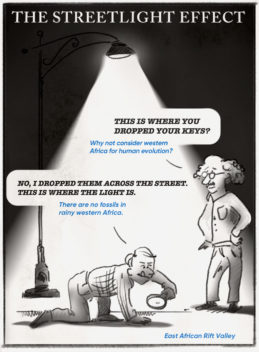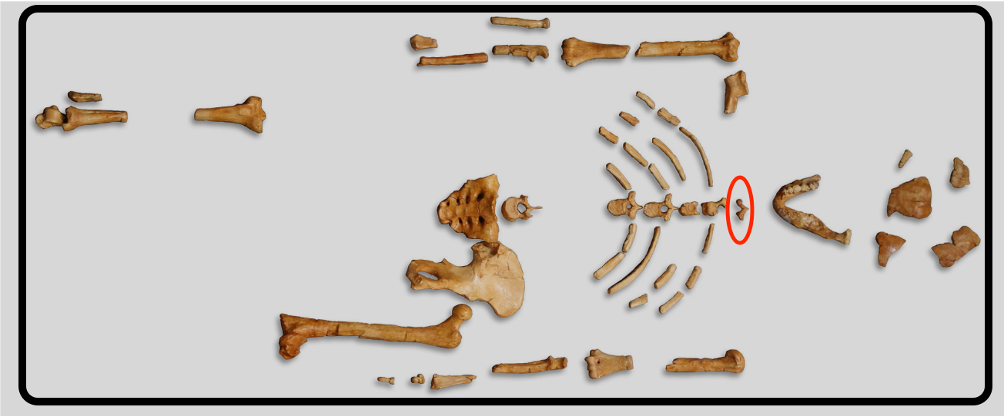Thinking outside the box of fossils
During the time of Darwin, anthropogeny was the study of human origins. Its sub-discipline paleoanthropology has since taken over, which focuses on fossils found in dry parts of Africa. These fossils don’t tell us much about why or where humans actually evolved.
“Lucy” is a collage of glued bone fragments, displayed together as a sort of skeleton. The pieces were discovered in Ethiopia in 1974, and are thought to be from a single ape − a possible human ancestor. The find is one of the most complete hominin fossils ever. But in 2015, researchers realized that one bone was from a baboon.
The fragments were found loose on the ground, in an area that had already been checked the previous year. They could have been put there by a prankster, to fool eager scientists.
This would be like the Piltdown Man. It was a collage made from human bone pieces and ape bone pieces. Specialists, with honest intentions, glued the pieces together. That collage fooled paleoanthropologists and the public for over 40 years, from 1912 to 1953.
- You might also like: Why aren’t house sparrows big as geese?
Paleoanthropology is not a very “scientific” science
People who work in paleoanthropology mostly make their interpretations based on bone fragments found on the ground. Selected fragments are made into collages, and the discovery sites become almost sacred − they are marked with a small monument.
The finds are unique, and can never be repeated. The bone materials are not chemically tested to see if they are equally old, or if they come from the same individual. (Fluorine testing proved that the Piltdown bones were not actually fossils.)
Researchers assume that the loose fossils come out of the nearby ground, which has a known geologic age. The fragments are studied by the finder’s own scientific team. They are too fragile and too valuable to be studied firsthand by independent and impartial scientists.
The success of a fossil find or fossil interpretation is measured by how many people accept it. These believers include scientists, media journalists, textbook authors, and the public. Success brings celebrity status and scientific funding to members of the team.
For these reasons, I argue that paleoanthropology is not a very “scientific” science: The key evidence is unique, and can never be obtained again. The evidence is not available for independent testing. Success is determined by the number of believers and how strongly they believe. It seems to me that paleoanthropology is somewhat like a religion.
You can read more about my ideas in an article published in Norwegian Sci Tech News, where I pointed out other problems with famous hominin interpretations.
- You might also like: How plants respond to attacks
Genetic studies have disproven many of paleoanthropology’s previous beliefs
Modern DNA research, without fossils, is making great progress in the study of human origins. DNA shows that humans and chimpanzees are closely related. They diverged from a chimpanzee-like ancestor less than 6 million years ago. This genetic insight suddenly made older ape fossils, and fossils that were not chimpanzee-like, less relevant for human evolution. They could no longer be considered our direct ancestors. Most scientists no longer claim that any pre-human fossil is a likely human ancestor.
Two specific types of DNA analysis, mitochondrial DNA and Y-chromosomal DNA, also show that all living humans descended from ancestors that lived in Africa less than about 300,000 years ago. This insight reduced the importance of older fossil fragments that had been found outside of Africa.

The interest in dry parts of Africa for human evolution is an example of the Streetlight Effect. (Drawing: Alex Krill)
Chimpanzees live in the humid forests of central and western Africa. DNA studies show that chimpanzees in these humid places have evolved into bonobos and into four different subspecies. Humans may have evolved there too. But fossils aren’t preserved in these wet areas, because damp bones decay very rapidly. For that reason, paleoanthropologists have not been interested in the chimpanzee regions of Africa. This is an example of the streetlight effect, where people look for answers in places where it is easiest to search, rather than where they might find the correct answer.
The aquatic ape hypothesis has been treated like a heresy
An unorthodox idea for the origin of human features was proposed in 1960 by the marine zoologist Alister Hardy. He suggested that many of our features evolved during some unknown period when we lived in a marine habitat. This idea became known as the aquatic ape hypothesis. The theory was well developed by the fiction-writer turned science-writer Elaine Morgan. But it didn’t fit with existing fossil evidence.
According to the aquatic ape hypothesis, apes learned to walk on two feet by wading in water to obtain food from the sea. Shellfish and seaweed are rich in certain omega-3 fatty acids, which could account for the extreme brain growth that characterizes humans. Fur is a disadvantage in water, and has been lost by many aquatic and semi-aquatic mammals. So an aquatic habitat would explain why humans are nearly naked. Blubber is an advantage in water, for thermal insulation and buoyancy. Human babies are born with blubber, and all humans have blubber-fat cells beneath the skin, which chimpanzees do not have.
These and many other features that point to aquatic evolution have been known for decades, but they have been kept out of peer-reviewed science journals. The aquatic ape hypothesis involves speculation, like all other hypotheses for human evolution. But it did not involve fossils. I believe that scientific discussion of these unorthodox ideas was discouraged because it would detract from the status of paleoanthropology.

The aquatic ape hypothesis can explain bipedalism, naked skin, blubber, external nose, long oily head hair, and all other human traits. Illustration: Alex Krill
In 2017 I suggested that humans may have evolved in the sea on the island of Bioko, a part of Equatorial Guinea. From the negative response to that article, I was able to improve my hypothesis. It has now been published in the peer-reviewed journal Ideas in Ecology and Evolution. So far, paleoanthropologists and media journalists have chosen to ignore it. For example, it was not included on an influential list that currently has 2769 publications relating to the origin of humans.
Bioko could have been “the Galapagos of human evolution”
The Galapagos Islands clearly show how isolated animals can dramatically evolve to create remarkable new species. The most interesting example of speciation on the Galapagos is the iguana. In all of South America and Central America there is only one species of iguana − the green iguana, which lives in trees. A female green iguana, pregnant with many eggs, is thought to have rafted on a floating tree to Galapagos about eight million years ago.
That iguana and its descendants survived on a diet of seaweed. As with humans, those animals evolved remarkable teeth, face, hands, feet, skin, and strategy for thermoregulation. Different species or subspecies of the marine iguana evolved on different islands. They are the only lizards in the world that obtain their food from the sea.
Some marine iguanas eventually found food on land. Their descendants abandoned the semiaquatic habitat. These iguanas still show the aquatic adaptations. Different ground-dwelling species inhabit different islands. They are all completely unlike the green arboreal iguanas of South America.
Such a path from arboreal habitat, to semiaquatic habitat, to ground-dwelling habitat, is what may have caused the unique human features to evolve on Bioko. How else could humans have evolved so differently than chimpanzees? Humans are unlike all other apes and monkeys. Yet DNA studies clearly show that humans are more closely related to chimpanzees than chimpanzees are to gorillas or other apes.

Chimpanzees in humid areas have evolved into bonobos (B) and four subspecies (Pt), with no fossils being formed in those places. Ape fossils are found only in drier areas (F). There are no chimpanzees or fossils on Bioko. Base map from Google Maps.
The alternative paradigm for human evolution
So here in a nutshell (but not yet in a box) is a new paradigm for human evolution: About 6 million years ago, a few chimpanzees rafted on a tree to one of the newly formed volcanic islands of proto-Bioko. The island had no forest foods, so the chimpanzees were forced to live on shellfish and seaweed. Evolution would favour chimps with longer legs and other features that were better at wading in water to gather food, allowing them to eventually learn to be bipedal. They learned to swim, and some swam over to mainland Africa, where they may have hybridized with apes. Hybridizations would explain the many species of bipedal hominins that left fossils in dry parts of the continent. The bipedal apes that remained on Bioko evolved into large-brained early humans. They came over to mainland Africa about 300,000 years ago and began leaving human fossils − first in dry parts of Africa, and later in Europe and Asia.
It is a simple paradigm that is compatible with all available fossils, because the fossils don’t actually show the evolution. This paradigm should be discussed in the context of anatomy and physiology, and tested by further studies of DNA. The sooner that it becomes known, the sooner that geneticists will attempt the types of DNA study that might be able to prove it.
Paradigm shifts are unpopular, unless they involve an obvious economic benefit. Unfortunately, the aquatic ape paradigm would weaken most aspects of paleoanthropology that involve fossils − fossil sites, museum collections, specialized university departments and journals.
It is natural that the aquatic ape paradigm is currently avoided by paleoanthropologists. Any discussion of it casts doubt on the paradigm that they need to work within.
If there is a paradigm shift, most of the previous results of paleoanthropology would be considered to be paleoprimatology, the study of ancient primates. Anthropogeny would again be the leading study of human origins. It would no longer include paleoanthropology as one of its sub-disciplines.
Reference: A paradigm for the evolution of human features: Apes trapped on barren volcanic islands Ideas in Ecology and Evolution. Jan. 31, 2020. https://doi.org/10.24908/iee.2020.13.1.n


